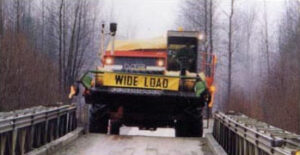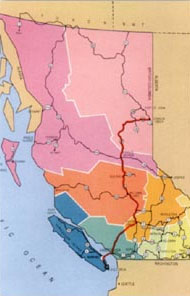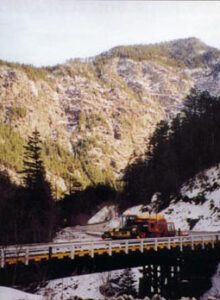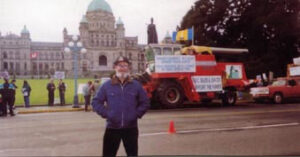 Traveling With a Hope and a Prayer
Traveling With a Hope and a Prayer
Farmington, B.C.
Canada’s Peace River Country is an idyllic region of rolling hills, clear air, and sparkling water. It straddles the dividing line between Alberta and British Columbia. Dawson Creek, one of its major communities, sits at Mile Zero on the Alaska Highway. This is a land settled by rugged pioneers determined to be successful farmers in an environment that can pose more challenges than most.
Nick Parsons is a latter-day Peace River pioneer who left Gloucestershire, England and settled in the Farmington, B.C. district in 1991 along with his wife, Jane, and daughters Catherine and Emily (now aged 12 and 11, respectively). “We were experiencing hard times in the U.K. in the late ’80s,” recalls Nick. “High interest rates were really putting the squeeze on farmers. I was primarily involved in custom farming and there were fewer and fewer farmers who could afford to pay for my services.”
It was a difficult decision for Nick to sell his farm in England and move his family thousands of miles west. He was, however, determined to make a fresh start and to continue to live close to the land. “Food is a necessity to all who live in this world and that is what farming is here to maintain,” Nick says.
In 1991, Nick moved to British Columbia’s Peace Country expecting one bad grain harvest in five years. However, Mother Nature has a way of ignoring statistical averages. “First we were tested by the drought of 1992 but that was nothing compared to the severe wet weather in the back-to-back growing seasons of 1996 and 1997,” says Nick. “In 1997, we were late starting our harvest because the fields were so waterlogged. Then, in early October, we had a freak 12″ snowstorm which downed most of our crops. Equipping swathers and combines with dual wheels or four-wheel drive didn’t have much of an impact and some farmers were only able to get between 0 and 30% of their crops harvested.”  Devastated by the second crop failure in two years and frustrated by the provincial government’s apparent lack of concern, Nick decided to take some action to publicize the plight of the area’s farmers. “On Canadian Thanksgiving Day, I drove my combine, dual wheels and all, some 20 miles to Dawson Creek and parked it at Mile Zero on the Alaska Highway with a sign that read ANOTHER HARVEST LOST. DISASTER IN THE COUNTRY.”
Devastated by the second crop failure in two years and frustrated by the provincial government’s apparent lack of concern, Nick decided to take some action to publicize the plight of the area’s farmers. “On Canadian Thanksgiving Day, I drove my combine, dual wheels and all, some 20 miles to Dawson Creek and parked it at Mile Zero on the Alaska Highway with a sign that read ANOTHER HARVEST LOST. DISASTER IN THE COUNTRY.”
Nick’s concern was shared by many of his neighbours and a Farm Crisis Committee was formed to put some pressure on the government for a relief package. In November, Nick volunteered to drive his combine to Victoria, the provincial capital of British Columbia, to push for recognition of the problem. The government did respond to this initiative by sending the agriculture minister to meet with local farmers in Dawson Creek three days before Nick’s intended departure date. However, the level of aid offered fell far short of what had been hoped for and farmers were left feeling frustrated and embittered.
Nick resurrected his plan to drive his combine to the provincial capital but, by this time, many of his fellow Farm Crisis Committee members felt that further action was futile. “I just couldn’t let it drop, though,” says Nick. “What’s the point of continually rehashing the issues in the coffee shop and not getting out and doing something? To me, the combine is the symbol of harvest all over the world and everybody eats what has been harvested by these machines every day. What better way of putting pressure on the government than to drive my combine 800 miles over a few mountain ranges?”
So it was that on January 10, 1998, Nick Parsons set off alone for the Provincial Legislature in his 17 year old Massey Ferguson Model 860 combine harvester, fondly known as Prairie Belle. “I had no support,” Nick recalls. “My back-up team pulled out because of the intense cold. I had a difficult and delayed start — the temperature was minus 40oC ( -40oF) and the extreme cold gelled the diesel fuel and thickened the hydraulic oil in the power steering.” Nonetheless, Nick pressed on to Chetwynd and his protest was officially underway.
At the request of logging truck operators, Nick had agreed to be trucked through Pine Pass across the Rocky Mountains. “As it turned out, temperatures below -40oC meant that logging trucks couldn’t drive so I cancelled the arrangement and had a go at it myself. Fortunately, Prairie Belle was able to conquer the pass without any significant trouble.”
A new problem arose on Day Three in Mackenzie Junction when Nick discovered that the starter motor on the combine didn’t want to start. He took it apart and discovered it was worn out. “Luckily, I was able to get parts flown up from Prince George and I repaired the motor myself in less than two hours.”
 Trouble of a different kind was encountered near Cache Creek when the Department of Transport impounded his combine. “The police and the D.O.T were trying to keep me off the major routes and I had inadvertently strayed onto the Trans Canada Highway. Under cover of darkness, I was able to reclaim my combine and find an alternative route.”
Trouble of a different kind was encountered near Cache Creek when the Department of Transport impounded his combine. “The police and the D.O.T were trying to keep me off the major routes and I had inadvertently strayed onto the Trans Canada Highway. Under cover of darkness, I was able to reclaim my combine and find an alternative route.”
With the Rocky Mountains safely behind him, the next major challenge Nick had to face was the Coast Mountain range running along the western edge of British Columbia. “A farmer from Pemberton, near Whistler, came to meet me at Lillooet,” Nick recalls. “He told me that if I made the first bridge, he would get me across the rest. Fortunately, I made the first bridge with 2″ to spare and all the other bridges were the same width. Still, that was quite a journey. The road was full of twists and turns with gradients up to 20% and the surface was slippery and snow-covered.”
With a great feeling of relief, Nick reached the ferry terminal at Horseshoe Bay, north of Vancouver and prepared to embark for the provincial capital, Victoria, which is located on Vancouver Island. “As soon as I arrived on Vancouver Island, it seemed like all my transportation worries were over. A deputation of police were waiting for me on the outskirts of Victoria. Instead of impounding my combine, they congratulated me and provided me with a motorcycle escort to the government buildings!”
As the good news of Nick’s triumphant 12-day journey spread, a busload of farmers from the Dawson Creek area also made its way to Victoria and, with support coming from a variety of sources, a big rally was held. Talks were re-opened with government officials and some additional aid to farmers did result. “I’d be the first to admit that our protest didn’t result in a whole lot of extra money for us farmers,” Nick explains. “However, I think we were very successful in getting the government to pay more attention to our region’s needs. All we wanted is a fair share of the Fair Share Program (funds that are available for investment in local infrastructure). As a region, we give the province a lot — lumber, oil, natural resources, and agricultural products. It shouldn’t be too much to expect to get a little something in return.”
The government has promised more money for infrastructure and Nick feels that his gruelling trip was well worth the effort. “Prairie Belle managed to draw a lot of attention to our situation,” Nick explains. “Travelling down the highway, there weren’t 15 minutes that passed without one or more people honking their horns and waving their hands in support. And, of course, the media followed us every step of the way.”
But there’s another, perhaps more compelling, reason why Nick embarked on the journey of a lifetime. “People kept telling me it couldn’t be done,” says Nick with a laugh, “and if anybody tells me that, I just have to go out and do it.”
Prairie Bell Thrived on Power Up
Nick Parsons’s combine harvester — the justly famous Prairie Belle — is a Massey Ferguson Model 860 which has completed seventeen years of work. Its average speed is about 25 kilometers (15.5 miles) per hour with a diesel fuel consumption of a little better than 8 kilometers (5 miles) per gallon. “Several people told me that the transmission wouldn’t be able to handle the continuous high gear work involved in taking it on the highway for 800 miles (1,280 kilometers),” Nick recalls. “They all told me I’d cook it and that the trip would be a complete waste of time and money.”
Prior to setting out, Nick contacted his local Power Up representative. “I figured I would need the best quality lubricants available, especially since I knew the combine’s gearbox transmission was not designed for continuous high gear operation. I had heard that Power Up products were good and decided to give them a try.”
Prior to departure, Power Up lubricants were added to the motor, planetaries, and transmission with spectacular results. “The transmission stayed cool and performed 100%,” reports Nick. “As I travelled further south and the weather warmed up, overheating could have been a real problem but it wasn’t. The motor clocked 100 hours on the trip and then I put an additional 60 hours on it when I returned. Throughout these 160 hours of work it used only one pint of oil — prior to using Power Up this motor used at least a pint of oil every 10 hours!”
Since his return, Nick has added Power Up lubricants to all his farm machinery. “Most of my equipment is quite old and I’ve noticed some significant improvements. For example, my John Deere 4020 with over 10,000 hours used to be very sluggish. Now it shifts quickly into reverse and the trans-temperature gauge reads lower all the time.”
 Nick is thrilled, too, with the improved performance of his Ford 700 grain truck. “I added Power Up to the engine and power train and this has resulted in improved oil pressure and virtually no oil usage. Surprisingly enough, I’ve gone up a gear on the slopes I have to travel when hauling grain into Dawson Creek. She just flies along now!”
Nick is thrilled, too, with the improved performance of his Ford 700 grain truck. “I added Power Up to the engine and power train and this has resulted in improved oil pressure and virtually no oil usage. Surprisingly enough, I’ve gone up a gear on the slopes I have to travel when hauling grain into Dawson Creek. She just flies along now!”
Power Up is proud to have been of assistance to Nick in ensuring that Prairie Belle made it to her destination and we wish him good luck in all his future endeavours.
